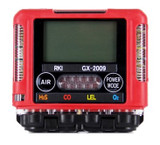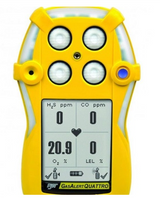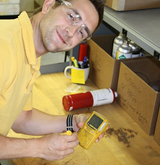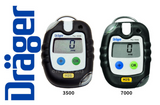Blog
RKI Instruments Confined Space Gas Monitors
RKI Instruments isn't a sexy company. They don't spend their money on fancy marketing handouts or ad campaigns, and they often name their instruments after the year they were launched. So why do so many companies prefer RKI gas detectors to all others? Maybe it's because their products flat-out work, and continue to work (properly cared for) for years and years.
RKI Instruments has been in business for 20 years and produces some of the most sophisticated gas monitoring devices on the ma
…
Jan 14th 2016
BW Quattro 4-Gas Monitor Low Cost of Ownership
When considering which personal gas monitors to use for your facility the long-term cost of ownership is going to be at the top of your list. Replacing sensors and hardware over time can be expensive, but so can replacing entire monitors. The
BW Quattro has a two-year sensor warranty which makes it a popular choice for companies who like to know when costs are likely to occur.
When considering the right monitor for your operation, you need to take into account a few critical bits of
…
Feb 18th 2015
Gas Detector Bump Test: Bump Testing and Calibration of your Gas Monitors
Gas monitors need regular calibration and bump testing if you want to be sure they are working properly. Like a guitar, monitors can drift out of tune. You've got a couple of choices to get it working properly. And as everyone who owns a gas monitor knows - whether it's a multi-gas monitor like the GasAlert Micro Clip XT, or a single-gas monitor like the
Gas Clip Technologies H2S Monitor - a quick bump test before using it to protect your life is an excellent, and highly recommen
…
Jan 14th 2015
BW Honeywell Factory-Trained Gas Monitor Know-It-Alls
Before we upgraded our facilities, sent our tech guys to Level 3 BW Honeywell gas monitor training, and increased our factory-direct parts supply to become a
BW Factory Authorized Service Center, these guys were already pretty unbearable. Sure it was handy to have someone around who could drill down to the smallest detail of monitor capabilities and explain error codes while grabbing their lunch from the company fridge. It's the calibration knowledge, the sensor life, the warranty informat
…
Jan 8th 2015
Getting The Right Gas Monitor For Your Company
Gas detection is serious business no matter what type of work you do. Your company may not need the level of protection a petroleum production facility requires, but every company using gas detection technology wants to make a good investment in their monitors. Some work sites need to know if hydrogen sulfide levels change even a small percentage. Others are fine waiting for the alarm to sound. The differences in your gas monitoring needs will affect the type of gas monitor that's right for y
…
Oct 29th 2014
New Alarm Point Settings on RKI Portable H2S Monitors
Recently
RKI Instruments sent out a notice explaining a change to their alarm settings on Eagle 2, GX-2009, and GX-2012 monitors. In order to comply with new industry standards developed by the fine folks at the American Conference of Governmental Industrial Hygienists (ACGIH), RKI Instruments is lowering their Hydrogen Sulfide (H2S) threshold limit values.
These aren't the regular lower level alarms (like someone who writes blogs and has two thumbs first thought). These are the expo
…
Jun 2nd 2014
Draeger Pac 3500 and Pac 7000 Monitors Really Are Different
Draeger has created some of the most widely used and accurate industrial gas detection devices in history. But many of the
single-gas units look exactly alike. What are the differences and why are they trying to confuse us?
We've all heard it's what's on the inside that counts. That is especially true for the Draeger
Pac 3500 and Pac 7000 single gas monitors. The housings are exactly the same, and at a glance you'd be hard pressed to tell the difference. But these two monitors var
…
May 27th 2014
H2S Monitor Bump Test: How Often Should My H2S Monitor Be Bump Tested?
A customer from the Chinese division of a large petroleum company emailed us this week to ask how often their
BW Clip H2S Monitors should be bump tested. Since we sell more of these monitors than any other at PK Safety Supply, it would seem logical that we'd have a ready answer. But we don't.
It's not because we don't care, or we don't think it's important. It is. Here's the situation: Officially, the manufacturer BW Honeywell recommends periodically testing the response of the hydro
…
Apr 28th 2014
Wireless QRAE 3 Confined Space Gas Detector from RAE Systems
RAE Systems is the manufacturer of the
QRAE 3, the newest multi-gas monitor for confined space entry. Up to four sensors can be configured in this device for combustible gases (LEL), Oxygen (O2), Carbon Monoxide (CO), Sulfur Dioxide (SO2), Hydrogen Sulfide (H2S), or Hydrogen Cyanide (HCN) depending on the specific needs of your facility.
The interesting thing about this monitor is the wireless configuration option. RAE Systems says this device will work in confined spaces as well. Fo
…
Apr 11th 2014
Draeger Pac 7000 Single-Gas Monitors
So many single-gas monitors are disposable these days. But not all of them. People buy disposable monitors for a range of reasons. Their workers lose them, or they want a fixed, measurable cost on their books. Some folks just want the cheapest monitor available so they are in compliance with OSHA regulations. But not every company falls into these categories. For companies who are serious about gas detection, the
Draeger Pac 7000 single-gas monitors make perfect sense.
Financially th
…
Mar 3rd 2014











